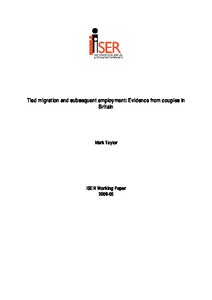Tied migration and subsequent employment: evidence from couples in Britain
"We use unique information on migration behaviour and the reasons for migration to study the impact of tied migration on labour market outcomes among husbands and wives. We find that fewer than 2% of couples migrate for job-related reasons, and that the majority of these move for reasons associ...
| Main Author: | |
|---|---|
| Institution: | ETUI-European Trade Union Institute |
| Format: | TEXT |
| Language: | English |
| Published: |
Colchester
2006
ISER |
| Subjects: | |
| Online Access: | https://www.labourline.org/KENTIKA-19125794124919439769-Tied-migration-and-subsequent-.htm |
| Summary: | "We use unique information on migration behaviour and the reasons for migration to study the impact of tied migration on labour market outcomes among husbands and wives. We find that fewer than 2% of couples migrate for job-related reasons, and that the majority of these move for reasons associated with the husband’s job. Estimates from dynamic random effects models indicate that husbands and wives in couples that migrated for job-related reasons suffer lower job retention rates than nonmigrants. Furthermore we find that tied migration reduces the probability of subsequent employment for both husbands and wives. In particular, tied migration has a large negative impact on job retention rates among wives." |
|---|---|
| Physical Description: | 29 p. Digital |

